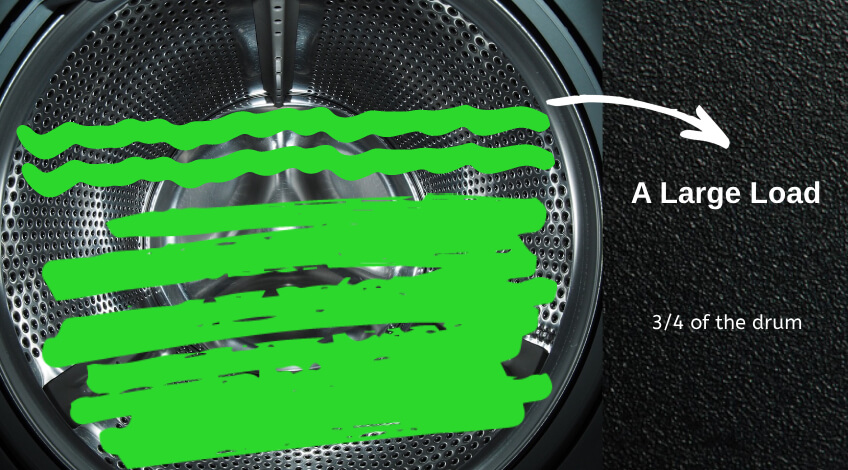
Condenser Tumble Dryer Keeps Stopping? Here’s why & what to do
Once your tumble dryer has been loaded, the cycle selected and the start button pressed, you expect the appliance to work. When you return to the appliance after an hour or so only to find your laundry is still wet and the cycle never even completed it can be annoying to say the least.
If this is the situation you find yourself in, keep reading. In this article we look at the reasons why condenser tumble dryers keep stopping and identify ways to solve this annoying issue.
Why Does My Condenser Dryer Keep Stopping?
There could be several reasons why a condenser tumble dryer stops mid-cycle. Which include;
| Possible Cause | Likely Solution |
|---|---|
| Power Supply Fault | Ensure The Plug Is Fully Inserted, The Socket Is Switched On And The Circuit Breaker Is Switched On |
| Water Reservoir Full | Empty Water Reservoir |
| Door Not Closed Properly | Ensure The Door Is Fully Closed |
| Ambient Room Temperature Too High | Cool The Room Down |
| Moisture Sensor Dirty | Clean The Moisture Sensor |
| Overloaded Or Underloaded Drum | Ensure There Is Laundry Within The Correct Weight Parameters In The Drum |
| Clogged Lint Filter | Clean The Lint Filter |
| Pump Fault | Replace The Pump If Necessary |
| Condenser Blocked | Clean The Condenser |
| Blown Thermal Fuse | Replace The Thermal Fuse |
| Defective Drive Belt | Replace The Drive Belt |
| Defective Timer | Check Timer And Replace If Necessary |
| Electrical Fault | Disconnect The Power Supply For 5 to 10 Minutes |
Let’s take a closer look at these faults;
Power Supply Fault
This might seem obvious but you’d be surprised just how often it’s something as simple as this that’s the cause of the problem. Check that the plug is fully inserted into the wall socket. Then check that the wall socket actually works by plugging a different electrical device in.
Ensure the socket is switched on and that the circuit breaker is switched on as well.
Water Reservoir Full
This is one of the most common reasons why condenser tumble dryers stop mid-cycle. If the reservoir is full, the appliance has nowhere to store any new moisture removed from the laundry. The appliance stops until the reservoir is emptied to prevent damage..
Some tumble dryers have an indicator light that lets you know when the reservoir is full. But yours might not, so if your dryer stops mid-cycle, you should always check the water reservoir first.
When emptying the water reservoir, you should also clean any lint, fluff or dirt that could cause a blockage. Then place an inch of fresh water in the bottom of the reservoir (consult your handbook for more instructions), replace the reservoir and start the dryer again.
Door Not Closed Properly
This is another common cause of condenser dryers stopping mid-cycle. This is usually caused by the door having been opened to add an extra garment or more often than not, the door wasn’t closed properly in the first place.
You will need to check that there are no obstructions preventing the door from shutting correctly. Look for clothes protruding into the doorway, sometimes a button or catch has become dislodged from an item of clothing and is stuck in the doorway somewhere.
If not, it could be the door clasp itself has become faulty and will need to be checked by a technician and ultimately replaced.
Ambient Room Temperature Too High
Condenser dryers work best in well ventilated, dry rooms. If the room the dryer is in is too hot and humid it will need to work harder to remove moisture from your laundry.
This can cause the dryer to overheat and shut down as a precautionary measure. You will need to ensure more ventilation and a steady airflow to keep the dryer working properly.
Moisture Sensor Dirty
Almost all modern tumble dryers have a moisture sensor which detects when the laundry is dry and stops the cycle accordingly. If the moisture sensor is dirty, it could give a false reading and stop the dryer prematurely.
You will need to find and clean the moisture sensor, which will either be at the back of the drum or close to the lint filter at the front of the appliance. If you can’t find the moisture sensor, consult your handbook or contact the manufacturer.
Take care when touching the moisture sensor if the appliance has just been running as the sensor could be hot. If the appliance has just been running, allow 10 minutes or so for the sensor to cool down before cleaning with a soft cloth.
If the sensor(s) are extremely dirty, use a soft cloth dipped in distilled white vinegar and thoroughly dry before reusing the appliance. You should then make cleaning the moisture sensor(s) a fairly regular task. You should aim to clean the moisture sensor at least every 3 months or so.

Overloaded Or Underloaded Drum
If you have overloaded the drum with too much wet washing, the outside of the pile might dry while the middle is still wet. This will mean the moisture sensor detects the dry laundry and shuts the cycle down.
Alternatively, not putting enough items in the drum can have the moisture sensor fail to register anything at all. This would also cause the cycle to finish mid-cycle.
You should always ensure that the amount of laundry you put into the dryer’s drum falls within the minimum and maximum parameters. Consult your handbook for more information.
Clogged Lint Filter
If the lint filter is clogged, the dryer will shut down to prevent any internal damage. You should remove the lint filter and remove any lint, fluff or dirt. Then run it under the tap to check that water flows through the filter freely.
If there is a shortage of water running through the filter, it’s likely that the mesh filter is still clogged. Try cleaning the filter again, and if it’s still the same, you might need to replace the lint filter.
Pump Fault
Condenser dryers pump water from the condenser tank into the water reservoir. If the pump develops a fault, the dryer will stop mid-cycle.
You can check that the pump is working by pouring some water into the tank without there being any clothes in the drum. If the pump is working correctly, the water should be removed to the reservoir.
If not, you will probably need to replace the pump and this is a job best left to a technician.
Blocked Condenser
The condenser is responsible for turning the hot air extracted from the clothes into water. Sometimes, the condenser can become blocked with lint or fluff which causes the sensor to think the condenser reservoir is full.
This will shut the dryer off mid-cycle. You will need to ensure that the water reservoir is emptied and the condenser is free from lint, fluff etc. This is a task that should be performed after every use to prevent this becoming a problem in the future.
Blown Thermal Fuse
The thermal fuse is a safety cut out that features in all tumble dryers. It is designed to blow and cut power to the appliance if it starts to overheat.
This is to protect the internal components of your dryer from becoming damaged. Once the thermal fuse blows, the appliance will not continue with whatever cycle it was running.
You will need to get the thermal fuse replaced before normal operations can continue. If the thermal fuse keeps blowing, there’s more going on than is obvious.
It could be any number of faults but the most likely is the motor is overheating. If this is the case, the technician will detect this when replacing the thermal fuse.

Defective Drive Belt
If you’ve got this far after trying all of the other solutions so far, it’s possible that the drive belt is defective. You can test this by opening the dryer’s door and turning the drum by hand.
If there is no resistance at all when you turn the drum, it’s likely that the drive belt is defective or broken.
The drive belt will almost certainly need to be replaced and this is a job best done by an expert. Contact your manufacturer or a tumble dryer technician to fit a new drive belt on your appliance.
Defective Timer
If your tumble dryer has a mechanical programmer it could have become defective and developed a fault. This could stop the appliance mid-cycle.
You will need to get an expert to check and replace the timer if it proves to be defective.
Electrical Fault
There are several reasons why an electrical fault could cause this annoying problem. Anything from a power surge to a major component failure.
In many cases, all you need to do is disconnect the appliance from the electricity supply for 5 to 10 minutes. After 10 minutes or so, reconnect the power and try the dryer again. In many cases the problem will have resolved itself.
If this never solved the issue you will need the help of an expert to fix this for you.
Why Are Condenser Dryers So Popular?
More and more people are buying condenser tumble dryers because they are so much more convenient than vented dryers. The problem with vented dryers is they need to be set up close to an outside wall to allow the warm, wet air to escape.
Condenser dryers can be set up anywhere (within reason). This is because the hot air is passed over a condenser and the water vapour is turned into water which is collected in a water reservoir.
This reservoir needs to be emptied on a regular basis but apart from that, there’s hardly any maintenance needed (except cleaning the lint filter of course).
Plus, there’s no need for any holes in the wall, or any plumbing which is why condenser dryers have become so popular.
SEE ALSO: Heated Airer Vs Tumble Dryer: Which is really best?
Frequently Asked Questions
Your tumble dryer will not work unless the door is fully closed. If it starts and then stops abruptly it’s more than likely due to a faulty door latch or switch. Or it could be the condenser is clogged, the filter is blocked or the water reservoir is full.
In some cases the dryer could stop immediately after starting if the motor is overheating. If the dryer will start again once it has cooled down it is most likely to be the motor that is overheating and will probably need to be replaced.
If your tumble dryer stops after 3 minutes it is almost certainly caused by a defective drive motor.




